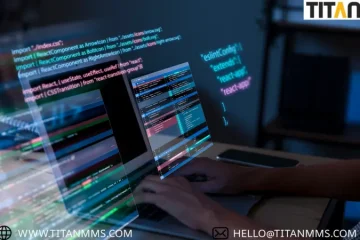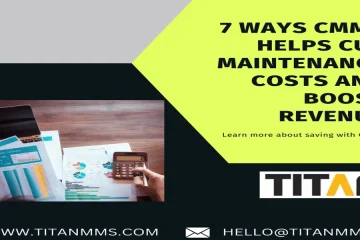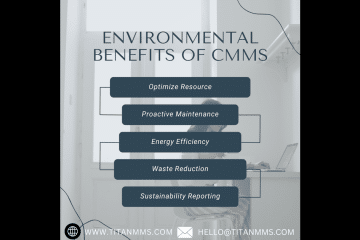In today’s fast-paced industrial world, managing maintenance efficiently is crucial. This is where a modern Computerized Maintenance Management System (CMMS) comes into play. A CMMS can transform how businesses handle maintenance tasks, ensuring equipment longevity and operational efficiency. But with so many options available, what features should you look for in a modern CMMS?
Let’s dive into the top five features that can make or break your maintenance management experience.
Feature 1: User-Friendly Interface
When it comes to software, usability is king. A user-friendly interface ensures that all team members, regardless of their tech-savvy, can navigate the system effortlessly.
Ease of Use:
A Computerized Maintenance Management System (CMMS) should have an intuitive design, allowing users to quickly access and perform necessary functions without getting bogged down by complex menus and commands. This reduces the learning curve and increases productivity from day one.
Training and Onboarding:
Look for a CMMS that offers comprehensive training and onboarding resources. This could include tutorials, webinars, and a dedicated support team to help users get up to speed quickly.
Feature 2: Mobile Accessibility
In an age where mobile devices are ubiquitous, having mobile accessibility is non-negotiable. Maintenance teams often need to access the Computerized Maintenance Management System (CMMS) while on the go, making this feature incredibly valuable.
Importance of Mobility:
With a mobile-accessible CMMS, technicians can check work orders, update statuses, and record data directly from the field. This real-time access ensures that no task slips through the cracks.
Mobile App Features:
A robust mobile app should offer offline capabilities, push notifications for urgent tasks, and an easy-to-use interface that mirrors the desktop version. This keeps the entire maintenance team connected and informed, no matter where they are.
Feature 3: Preventive Maintenance Scheduling
Preventive maintenance is a proactive approach to keeping equipment in optimal condition. A modern Computerized Maintenance Management System (CMMS) should make scheduling and managing these tasks straightforward.
Benefits of Preventive Maintenance:
By scheduling regular maintenance, you can prevent unexpected breakdowns and extend the lifespan of your equipment. This not only saves money but also boosts productivity.
Automated Scheduling:
Choose a CMMS that offers automated scheduling features. This means the system can generate work orders based on predefined intervals, ensuring that preventive tasks are never missed.
Feature 4: Inventory Management
Effective inventory management is essential for minimizing downtime and ensuring that necessary parts and supplies are always on hand.
Tracking and Ordering Parts:
A good Computerized Maintenance Management System (CMMS) should track inventory levels in real time, alerting you when stock is low. It should also facilitate the ordering process, either through direct integration with suppliers or by generating purchase orders.
Integration with Suppliers:
Integration capabilities with suppliers can streamline the procurement process. This ensures that parts are reordered automatically when needed, reducing delays and keeping maintenance schedules on track.
Feature 5: Real-Time Reporting and Analytics
Data is powerful, but only if you can interpret it correctly. Real-time reporting and analytics are vital for making informed maintenance decisions.
Data-Driven Decisions:
A Computerized Maintenance Management System (CMMS) should provide comprehensive data analytics, allowing you to track key performance indicators (KPIs), identify trends, and make data-driven decisions. This can lead to improved efficiency and cost savings.
Customizable Reports:
Look for a system that offers customizable reports. This allows you to tailor the data to your specific needs, whether you need to present it to management or use it to fine-tune your maintenance strategies.
Additional Features to Consider:
While the top five features are critical, there are several other features that can enhance the functionality of a CMMS.
Integration Capabilities:
A CMMS should seamlessly integrate with other systems you use, such as ERP software, to provide a cohesive operational experience.
Customization Options:
Every business is unique, so having a CMMS that can be customized to fit your specific processes and workflows is highly beneficial.
Security Measures:
Since a CMMS houses sensitive data, robust security measures are essential. Ensure that the system offers data encryption, regular backups, and user access controls.
How to Choose the Right CMMS for Your Business:
Selecting the right Computerized Maintenance Management System (CMMS) involves more than just looking at features. It’s about finding the right fit for your specific needs and ensuring it will grow with your business.
Assessing Your Needs:
Start by identifying the unique maintenance challenges your business faces. This will help you determine which features are most important for your operations.
Comparing Options:
Research various CMMS options, comparing features, user reviews, and pricing. Many vendors offer free trials, which can be a great way to test the software before committing.
Getting Feedback from Users:
Involve your maintenance team in the decision-making process. Their firsthand experience and feedback can provide valuable insights into which system will work best in practice.
Conclusion
Choosing a Computerized Maintenance Management System (CMMS) is a significant decision that can have a profound impact on your maintenance operations. By focusing on user-friendly interfaces, mobile accessibility, preventive maintenance scheduling, inventory management, and real-time reporting and analytics, you can select a system that enhances efficiency and productivity. Remember to consider additional features and involve your team in the selection process to ensure you find the best fit for your needs.
FAQs
Q.1 What is a CMMS?
Ans. A Computerized Maintenance Management System (CMMS) is software designed to streamline maintenance management by organizing and tracking maintenance activities, work orders, and inventory.
Q.2 How does a CMMS improve maintenance processes?
Ans. A CMMS improves maintenance processes by automating tasks, providing real-time data, and facilitating preventive maintenance, which reduces downtime and extends equipment life.
Q.3 Can a CMMS be used in any industry?
Ans. Yes, a CMMS is versatile and can be used in various industries, including manufacturing, healthcare, facilities management, and more.
Q.4 How much does a CMMS typically cost?
Ans. The cost of a CMMS can vary widely depending on the features and scale of the deployment. Pricing models often include subscription-based plans, which can range from a few hundred to several thousand dollars per month.
Q.5 What are the challenges of implementing a CMMS?
Ans. Challenges can include the initial cost, the time required for training and onboarding, and resistance to change from staff. However, these challenges are often outweighed by the long-term benefits.
To read More Blogs Click Here!




0 Comments